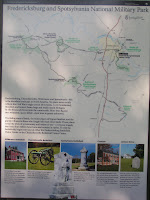
As you know, we usually don’t do any sightseeing on the weekends, but this stop proved different because Scott would be parting company with us Mon. morning. So Sat. we drove to the Fredericksburg and Spotsylvania National Military Park Visitor’s Center (http://www.nps.gov/frsp/), which memorializes the battles of Fredericksburg, Chancellorsville, the Wilderness, and Spotsylvania Courthouse – four major engagements of the Civil War. Within a radius of 17 miles, more than 100,000 American causalities occurred. When we arrived, we watched a brief film on the battles, toured the exhibits in the Center, and then took the self-guided driving tour t
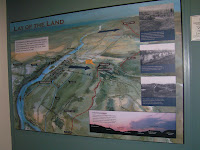
hrough the Fredericksburg area. We always watch the movie that is available for viewing at almost all national park headquarters, as they do an excellent job of describing the significance of the area we are touring. Since most of our travels have been in the east, a number of national parks and monuments relate to the Civil War. In viewing these films we are always struck by the hardships, destruction, and death suffered on both sides during t
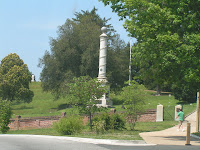
he war. It is at these moments that we take the time to reflect on truly how lucky we are.
Next to the visitor’s center is the Fredericksburg National Cemetery located on Marye’s Heights, the site of the North’s worse defeat up to that point in the war. More than 15,000 Union soldiers are buried there with 85% of the soldiers’ identities unknown. The drive continues through the hist

oric district of Fredericksburg to Chatham Manor, a plantation home that was used as a Union headquarters and a field hospital. The estate, situated atop a hill, once overlooked the entire town but now the trees and brush obstruct the view. As we continued the drive there were stops at Lee’s Hill, Howison Hill, and the spot of the Union breakthrough (all important battle sites), but there really wasn’t much to see because of all the trees. The last stop was at Prospect Hill, which was the right end of Gen. “Stonewall” Jackson’s line, and where once again the Confederates held off the Union troops.
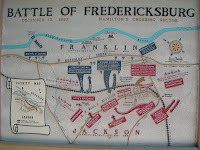
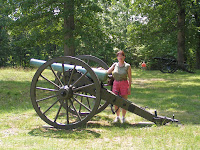

Sun. was a day of rest for us while Scott was busy preparing for his next day’s departure. We got together that evening for dinner with Scott providing the beef for kabobs and hash browns, which we supplemented with salad and garlic bread. We toasted with a bottle of Merlot to “good friends and safe travels”. We have traveled together now for two months, and it was with a touch of sadness that we were going to part. After all, who was Russ going to have all those political discussions with! We were sure to wake early on Mon. to see Scott and Bonnie off and wish them well. We may catch up a
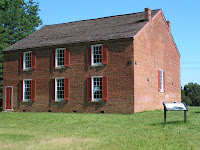
gain in late Aug. when we’re back in Eureka, MO, where we first met.
After breakfast, Russ and I drove towards the Chancellorsville battlefield, which is considered the greatest victory of Gen. Robert E. Lee’s career. But on the way we stopped at Old Salem Church, built in 1844, and where in 1863 Lee defeated the Federals (Union) in a daylong battle. Immediately after the bat
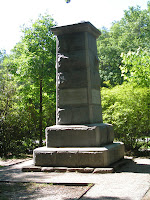
tle, the church became a field hospital where southern doctors attended to wounded soldiers of both armies.
Upon arrival at the Chancellorsville visitor’s center, we learned that it was located where Gen. Jackson was critically wounded by friendly fire in 1863. His left arm was amputated, and 6 days later “Stonewall” Jackson died of pneumonia. This granite monument was erected in 1888 as a tribute. On one side it reads: “On this spot fell mortally wounded Thomas J. Jackson Lt. Ge
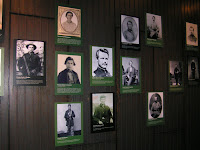
n. C.S.A. May 2nd, 1863”. After the brief walking tour around the building to see these sites, we naturally watched the film, and then toured the exhibits before starting our drive. One o
f the walls in the center had photos of men and women who were in the war or were affected in some way by it, again bringing home the reality of the conflict.
Chancellorsville was not a town but a house sit

uated at the strategic crossroads of three roads that led to Fredericksburg. Built by the Chancellor family in the early 19th century, Frances Chancellor and her 6 children were relegated to a back room when Union troops took over the house as their headquarters. On May 3, 1863, a shell struck the house, starting a fire. The family was huddled in the cellar as the war raged above and did not know their ho

use was on fire until a Union staff officer came and led them to safety. As you can see, there’s not much left of the house even though it was rebuilt after the initial fire, the second one burnt down as well. Further along the drive we came upon the Catharine Furnace ruins. Catharine Furnace was a large industrial complex that was built in 1837,

and though closed a decade later, it was re-opened to meet the Confederacy’s need for wartime iron. Union troops engaged Jackson’s rearguard here, and though several hundred GA troops were captured, the Union failed to stop Jackson’s men. This stone smoke stack is all that remains of this major iron operation. We continued the drive admiring the beauty of the forest, reading the placards at each tour stop, and realizing what devastation these woods had seen. Most of the battlefields we had visited
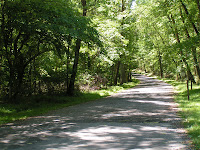
thus far were open fields, or the trees had grown up over the years, but these battles actually took place with the men fighting their way through the vegetation and at times hiding and being protected by the trees.
We traveled on to where the Battle of the Wilderness occurred, the first of the classic encounters between Lee and Uly
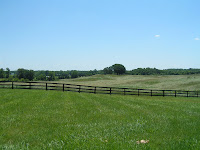
sses S. Grant. This and the next battlefield do not have visitor’s centers but rather exhibit shelters, so no movies to watch, just plenty of pictures and posters explaining the importance of these campaigns in the war. After Chancellorsville, the war had moved north to Antietam and Gettysburg, but in May 1864 it moved back to this area. By then there had been ne
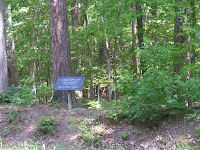
arly half a million northern casualties, and Grant was appointed general-in-chief of Union armies by President Lincoln to put an end to the conflict. This area is where Grant made his headquarters, and for two days sparred with Lee in a battle that ended in a stalemate. Grant had no desire to r
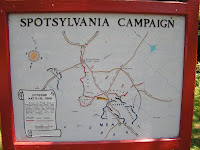
enew the conflict here, and after dark that night moved his army towards Spotsylvania Courthouse, 15 miles southeast from the battlefield.
Initially we had planned to visit Spotsylvania Courthouse another day, but it was o

n the way back to the campground, so we decided to go ahead and complete the tour. Spotsylvania Courthouse is actually an unincorporated community and not just the name of a courthouse as we had thought. Lee had anticipated Grant’s movement and marching all night, entrenched his troops before Grant’s arrived. For two weeks the two sides battled, and some of the most desperate hand-to-hand fighting occurred in a brutal 20-hour struggle through poring rain
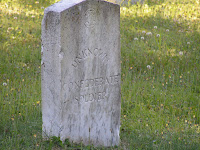
over a section of the Confederate line that became known as the "Bloody Angle". Though this battle also ended in a stalemate, it is said that the Battle of Spotsylvania Courthouse marked the beginning of the fall of the Confederacy.
As we drove back towards the campground, we passed the Confederate Cemetery and turned in. Here lie some 600 Confederat
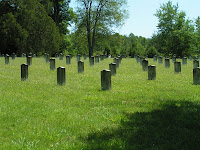
e soldiers from these four battlefields, several of the graves marked Unknown Soldier. In 1866 local women from a memorial association spearheaded the effort to have these soldiers re-buried here, organizing them by state. Headstones were provided by the Federal government, and a granite monument stands in the center crowned with a stone Confederate soldier silently standing watch.
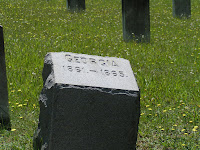
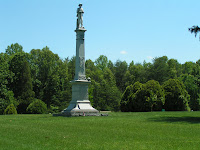
 At the last minute Mon. night we decided to go to the baseball game in D.C. the next night because St. Louis was playing the Washington Nationals. The game started at 7pm so we left here at 4:30 since we didn't know how the traffic would be, had to buy tickets, and park. We got seats along the left field sid
At the last minute Mon. night we decided to go to the baseball game in D.C. the next night because St. Louis was playing the Washington Nationals. The game started at 7pm so we left here at 4:30 since we didn't know how the traffic would be, had to buy tickets, and park. We got seats along the left field sid e about 28 rows back, and just as the game started, it began drizzling. They played thru 3 innings like that (we had an umbrella and I put on a rain poncho), and after the first batter in the top of the 4th, the skies opened. Bottom line there were 2 rain delays totaling 2 hr. 40 min., and the ground crew definitely earned their money this night! We finally left during the 7th inning stretch at
e about 28 rows back, and just as the game started, it began drizzling. They played thru 3 innings like that (we had an umbrella and I put on a rain poncho), and after the first batter in the top of the 4th, the skies opened. Bottom line there were 2 rain delays totaling 2 hr. 40 min., and the ground crew definitely earned their money this night! We finally left during the 7th inning stretch at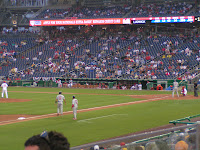 11:40pm! We got back to the RV at 1:10am, and the kids were definitely ready to go potty but they didn't mess inside!! The Cards won 6-1 (we listened to the end of the game on the radio on the way home), and just in time cause it was starting to pour again according to the announcers.
11:40pm! We got back to the RV at 1:10am, and the kids were definitely ready to go potty but they didn't mess inside!! The Cards won 6-1 (we listened to the end of the game on the radio on the way home), and just in time cause it was starting to pour again according to the announcers. 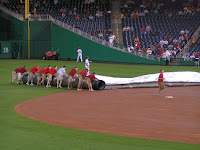
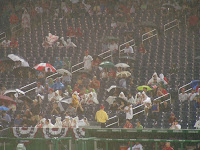

The games are held at the brand new Nationals Park, which is nice but not the best stadium we’ve seen in our travels. Even with this new park, attendance has not been very good, and in fact the night we were there I think the Cardinals fans outnumbered the Nationals fans…I know they did by the time we left! There was a whole contingent of Cardinals fans rooting and ch

eering on the 3rd base side behind the Cardinals dugout (by that time you could sit pretty much wherever you wanted.) Shortly before leaving we moved over to the section just above the Cardinals bullpen and was really cool watching the relief pitchers warm up from that angle. During the game (in spite of the rain) they hel
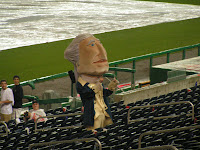
d their “Presidents’ Race”, which features the four Presidents found on Mount Rushmore: George Washington, Abraham Lincoln, Thomas Jefferson, and Teddy Roosevelt. The Presidents are dressed in period costumes and topped with giant foam caricature heads. Coming through the center field fence, they race along the warning track, turning for the final sprint along the first base foul line toward a makeshift finish line n

ear the Washington Nationals’ home dugout. The characters pose for pictures before the game and make appearances throughout the stadium during the game. The Nationals’ mascot “Screech” (a bald eagle) also made appearances in the stands.
Wed. was our day to prepare for the next day’s departure so nothing was p
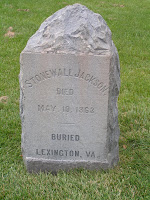
lanned (especially since my friend, Kristin who lives near Richmond, had to cancel our lunch date!) We did our Wal-Mart grocery shopping run and on the way back stopped at the Stonewall Jackson Shrine located just down the road in the town of Guinea Station. The shrine consists of a small outbuilding on the former Chandler plantation where Jackson died and a small stone monument. That night the storms returned, and it got pretty ugly. The rain and thunder seemed to surround us, and at one point we heard on the weather station that a tornado had touched ground 3 miles north of us in Fredericksburg. We pulled in both slides on the RV and determined a spot where we could both crawl under for some protection, but shoot, if a tornado hit this thing, it would probably be a moot point. Someone asked if there wasn’t somewhere at the campground where we could have gone, but most of the buildings here are wood structures so probably not much safer. But all’s well, and the next day we left for Front Royal, VA, about 90 miles up the road where the Shenandoah National Park and Skyline Drive along the Blue Ridge Mountains begins. It is also part of the Appalachian Mountains National Scenic Trail.
At the last minute Mon. night we decided to go to the baseball game in D.C. the next night because St. Louis was playing the Washington Nationals. The game started at 7pm so we left here at 4:30 since we didn't know how the traffic would be, had to buy tickets, and park. We got seats along the left field sid
e about 28 rows back, and just as the game started, it began drizzling. They played thru 3 innings like that (we had an umbrella and I put on a rain poncho), and after the first batter in the top of the 4th, the skies opened. Bottom line there were 2 rain delays totaling 2 hr. 40 min., and the ground crew definitely earned their money this night! We finally left during the 7th inning stretch at
11:40pm! We got back to the RV at 1:10am, and the kids were definitely ready to go potty but they didn't mess inside!! The Cards won 6-1 (we listened to the end of the game on the radio on the way home), and just in time cause it was starting to pour again according to the announcers.

2 comments:
I enjoy your blog, you are doing an outstanding job with that, although a picture of the head wound from hitting your head on the slidout would have been a nice addition. Sounds like you are having a great time. Tom
When I first moved to the Virginia/Delaware area from St. Louis 7 years ago, I was amazed and very pleased that there are so many Cardinals fans here. I see many STL caps. More so than any other team even though, the Phillies or the Orioles would be considered the "home team". However, this is a BIG football area and the majority root for the Eagles. That's O.K. I never did like the sound of the St. Louis Rams!!
Post a Comment